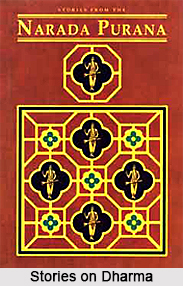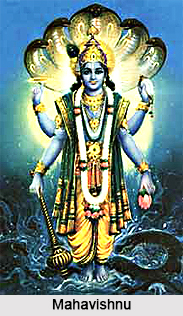 Stories on Dharma articulate on association with good people, on gifting land to needy,on chastity, gift of one`s life, on temple creation and tank renovation. These are the ways how the characters have attained final paradisiacal peace. The first story on Dharma deal with the solar king Bahu, son of Varka who was an arrogant man. He retreated to the forest with his two wives on being defeated by his foes and died there. His pregnant younger wife, who, wished to follow her departed husband by committing Sati, was prevented from doing so by sage Aurva. Due to the power of his austerities, Sage Aurva freed the king Bahu from all the crimes and helped him seek liberation.
Stories on Dharma articulate on association with good people, on gifting land to needy,on chastity, gift of one`s life, on temple creation and tank renovation. These are the ways how the characters have attained final paradisiacal peace. The first story on Dharma deal with the solar king Bahu, son of Varka who was an arrogant man. He retreated to the forest with his two wives on being defeated by his foes and died there. His pregnant younger wife, who, wished to follow her departed husband by committing Sati, was prevented from doing so by sage Aurva. Due to the power of his austerities, Sage Aurva freed the king Bahu from all the crimes and helped him seek liberation.
In Brahma Kalpa, there was a poor Brahmin named Bhadramati. He was an intellectual and devotee of Vishnu. He had six wives namely Shruti, Sindhu, Yasovati, Kamini, Malini and Shobha, and 250 sons. He along with his family went to Kausambi as he was not able to sustain them. There he approached a well-to-do Brahmana, called Sughosa and requested for a gift of ten feet of land. He gave him the required land by the merit of which he attained final salvation.
There is a chapter on King Virabhadra in Narada Purana. One day, while hunting out when he saw a dried-up tank on the peak of Saikata Mountain. He at once ordered his minister Buddhisagara to renovate the tank. Buddhisagara soon carried out the orders and the tank was made useful for all. The king, the minister and those responsible for repairing the tank attained salvation.
 A Shudra married a good woman who was dedicated to him. He also kept a prostitute with him. His wife served them without any feeling of resentment. Once he was afflicted with a disease, Bhagandara (fistula). The prostitute took all his wealth and ran from there. His wife still continued serving him genuinely. He passed away after some time. She sold her bracelet to cremate him and committed Sati. Her praiseworthy actions made her and her husband reach heaven.
A Shudra married a good woman who was dedicated to him. He also kept a prostitute with him. His wife served them without any feeling of resentment. Once he was afflicted with a disease, Bhagandara (fistula). The prostitute took all his wealth and ran from there. His wife still continued serving him genuinely. He passed away after some time. She sold her bracelet to cremate him and committed Sati. Her praiseworthy actions made her and her husband reach heaven.
Kaundinya, a Brahmin, married Sage Sumantu`s daughter and led a happy life. One day while returning from king"s palace he had brought home two prostitutes. He exhausted all his wealth within three years which led to poverty. He asked his wife to help him by giving her ornaments. She refused and went away to her father`s house taking all the articles from the house. Kaundinya left the place and roaming here and there reached a mountainous island. A Rakshasa named Gomila was staying with his wife. One day, he brought with him the Kasi king`s daughter Ratnavali. The rakshasa told his wife that he brought Ratnavali only to provide his wife with food and asked her to bring Kaundinya for his food. The rakshasi suspected his intentions in bringing Ratnavali and assuming the form of a beautiful girl of sixteen years went to Kaundinya. On seeing him she fell in love with him and requested him to marry her. She told him that in her earlier birth she was Kandali, the daughter of Aurva, and that she became a raksasi through her husband Durvasa"s curse due to her hot-tempered nature. On the advice of the raksasi, Kaundinya took the form of Shakti on raksasi"s advice killed the raksasa. The raksasi assuming elephant"s form took Kaundinya along with Ratnavali to Kasi. There Kaundinya married Ratnavali with the consent of the rakshasi and on receiving a lot of wealth from the Kasi king settled at Mahodayapuri with his wives. She died in her husband"s embrace and went to hell. After a long time, she attained Vaikuntha as she observed Ekadashi vrata.
A section on the demon Virochana, a performer of dharma, and son of Prahlada has been elucidate. His wife Vishalakshi daily used to invite a Brahmin and worship him. After the killing of Hiranyakashyap, gods were afraid of Virochana also. They went to Vishnu and requested him to kill the devil. Lord Vishnu approached Vishalakshi one morning in the guise of an aged Brahmin. She honoured and offered him a seat, but he never accepted it. He demanded from her a promise to fulfil his desires. She gave the promise, but he was not prepared to believe in the words of a woman. So, she called her husband and he agreed to fulfil his desires. Then Vishnu asked for their lives. Both of them gave their lives with pleasure and achieved liberty.












